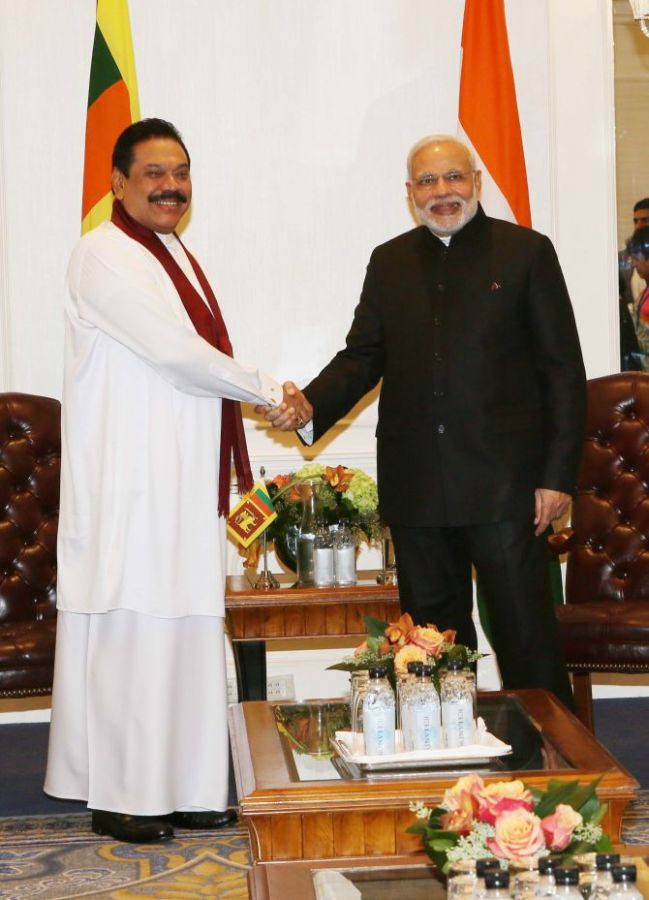 | « Back to article | Print this article |
Mahinda Rajapaksa recovered from his 2015 electoral losses, went to the people and campaigned about the injustice done to him.
Without attempting to be subtle, he underscored his image of the Sinhala Buddhist warrior a la Dutugemunu, the king of Sri Lanka (164 BC to 140 BC) who led the military campaign against the invading warlord Elara.
Aditi Phadnis reports.

When is the Opposition not in the Opposition?
When it is in government, obviously!
If only it were that simple.
This April, two political groupings were debating the existential dilemmas of being in the Opposition while also being in government, although their circumstances are very different.
The Communist Party of India-Marxist was discussing passionately whether it should stick to its position and struggle alone to bring about a revolution with Indian characteristics, marking a permanent place in the Opposition; or tie up with other parties, even those that are only marginally like-minded, to present a solid phalanx against the Bharatiya Janata Party that is intent on gobbling up India, ruthlessly eliminating what opposition stands before it. There are sections that are more comfortable being in the opposition.
Somewhat similar was the drama playing out in neighbouring Sri Lanka.
In 2015, the Sri Lanka Freedom Party, a left-leaning grouping in its economic outlook (but not in race relations), struck a deal with the right-wing United National Party to form a government in which, theoretically, everyone should have been happy.
The common enemy was Mahinda Rajapaksa, the outgoing president who had 'vanquished' the LTTE, the most feared guerilla group in the subcontinent, ending a three-decade war between the minority Tamils in North and East Sri Lanka and the majority Sinhala Buddhists.
The important thing to note here is: Rajapaksa ended the war, not the source of conflict.
His health minister, Maithripala Sirisena, walked out of the SLFP, became the presidential candidate for a job that should have put a full stop to the nepotism, cronyism and corruption of the previous government, restored the faith of the minorities and put Sri Lanka on a new growth trajectory.
Sirisena appointed Ranil Wickremesinghe as prime minister as the UNP had a majority in parliament and agreed to amend the constitution that truncated his powers as executive president.
Everything was hunky-dory for the first few months. All Sri Lanka reveled in the restoration of democracy.
Elements in the Rajapaksa administration were prosecuted, jailed and if they were abroad, hunted down.
A reset was attempted in foreign policy, correcting a seeming pro-China bias.
In other words, for a brief but crucial period, Sri Lanka had really no Opposition, only a government, because the Opposition was the government.
Obviously this state of affairs could not have endured. Rajapaksa recovered from his losses, went to the people and campaigned about the injustice done to him.
Additionally, without attempting to be subtle, he underscored his image of the Sinhala Buddhist warrior a la Dutugemunu, the king of Sri Lanka (164 BC to 140 BC) who led the military campaign against the invading warlord Elara.
Strategic support by him to the Sinhala Buddhist Bodu Bala Sena and its campaign against Muslim minorities led to severe rioting.
Add to this corruption in the form of the Bonds scandal that involved the Wickremesinghe-appointed central bank governor Arjuna Mahendran and Rajapaksa didn’t even have to try.
He swept the local government polls in February and became the legitimate opposition pole to which all the discontented (both in government and outside) rallied.
The Rajapaksa-led Joint Opposition then put in a motion of no confidence against the prime minister.
Sirisena, recognising which side of his bread was buttered, told SLFP MPs to vote according to their conscience. Some were ministers. They voted against their own prime minister. Naturally, they had to step down because Wickremesinghe won the no-confidence motion.
So now, in the excessively and punctiliously constitutional politics of Sri Lanka, there was a mess -- because everyone wants to sit on the Opposition benches.
The UNP was in a majority. But elements within the UNP made no secret of their disenchantment with the PM -- some abstained in the no confidence motion when the government needed every man on the deck in order to survive.
The power disequilibrium within the government was no secret, especially for the bureaucracy.
General elections in Sri Lanka were originally due in 2020 (after Sirisena dissolved parliament on Friday night, they will be held in January 2019).
Meanwhile, the questions remained: When is the Opposition, not in the Opposition?